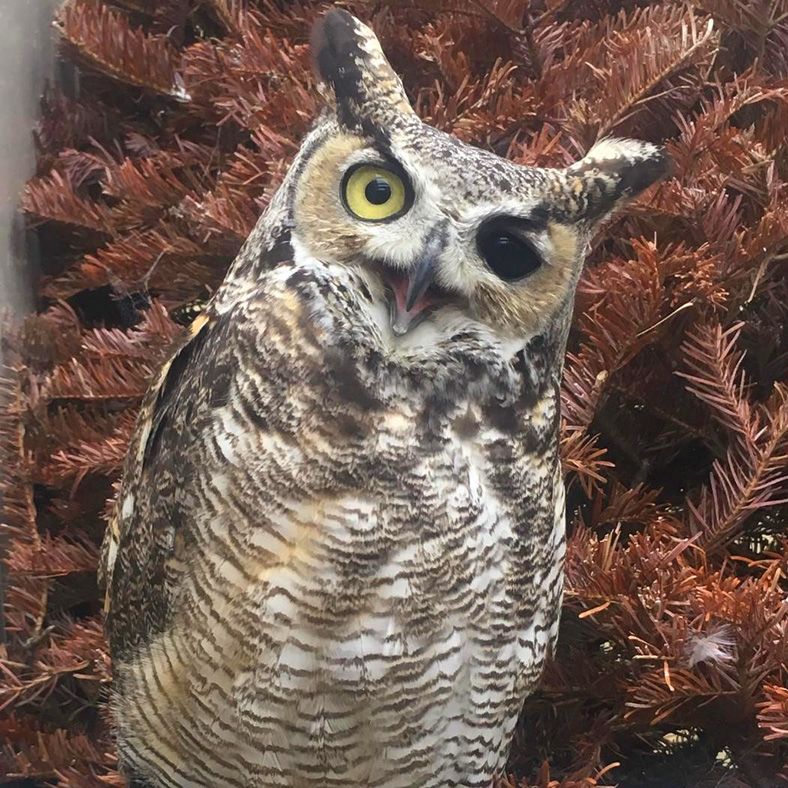Profile | Luna

-
BirthdayFemale, born 2003
-
SpeciesGreat horned owl
Bubo virginianus -
Professor ofFierce feathered foes
-
Field of StudyTalons and triangulation
-
Food and Vet Care$133 per month | $1596 each year
About the species
RANGE | The great horned owl is found throughout the continental United States, as well as in Alaska. Its geographic range extends south into Mexico, Central America, and South America.
FUN FACTS | The great horned owl is the most common owl in the Americas and is most easily recognized because of the two tufts of feathers on either side of their head, called plumicorns, that resemble horns. They are often called the tiger of the night because they have nearly the same grip strength as the significantly larger golden eagle, enabling them to carry heavier prey than most birds their size. They locate their prey by their sense of hearing. Owls' ears are asymetrically placed, enabling them to capture and analyze sounds from all directions, so they can triangulate the location of their prey. These nocturnal birds have incredible night vision- though very poor color vision. Their large eyes are fixed in place by bone so, to see around them, they must rotate their entire head. They have more neck vertebrae than we have so can turn their head 270–300 degrees as opposed to the 180 degrees we turn our head. When they hear a mouse, they fly with nearly silent flight due to design of feathers on the outside of their wings so their prey cannot hear them.
The primary job of the great horned owl is to hunt for rodents, managing their populations through predation and not poison.
Meet Luna
As a fledgling, birds will begin to make short flights from their next, building up strength and confidence to become independent at 5-6 months. When Luna was just 3-4 months old, she was practicing her flight on a particularly windy night and she wasn’t able to get back to her nest. She opened up her wings and began to head out over the road, when she collided with a truck. Thankfully, the driver stopped and rushed her to a wildlife hospital. Since it was night, her eyes and pupils were both opened wide to enable her to see in the dark. When she hit the truck, the impact caused the muscles in her eye to freeze, and so much light entered her eye, that the nerves were deadened. So now, she has one bright yellow eye, like it should be, and one black eye, with a fully dilated pupil. With sight in just one eye, she lacks depth perception so hunting would not be successful or safe for her to attempt.
When we do outdoor programs, the ravens and crows become very agitated and will vocalize loudly at Luna, sometimes even swooping down to divebomb her. Then, when she starts to hoot back, they then become absolutely silent.
Likes
She loves feeling enclosed, especially in her nest box but also in the plastic dog house she uses as a den. She will grab and carry small heavy duty dog toys, bringing them into her den and hiding them in the back corner. Like many of our other raptors, she likes to shred things in tubes and boxes. We have always thought it would be really interesting to get a few good trail cameras and see exactly how she plays with her enrichment all night long!
Wishlist
-
Heavy-duty dog toysby Kong, Vitscan, Hugglehounds, Ho-lee Roller balls, goDog, oneisall, JollyPets, Dogzilla eggs, different shapes/sizes of BoomerBalls, LPHNSUR ToughDogChews, or others made for chewers
-
Packing materialsheavy duty mailing tubes of various lengths and widths, plus packing boxes to fill and stack
-
Play structurestoddler play structures, kitchens, playhouses, workbenches, and picnic tables
-
Water toysby Outward Hound, Chuckit Bumper, ZippyPaws Floatiez, Kong, or even children’s bath toys like rubber ducks
-
Travel carrierto leave in enclosure for evacuation training